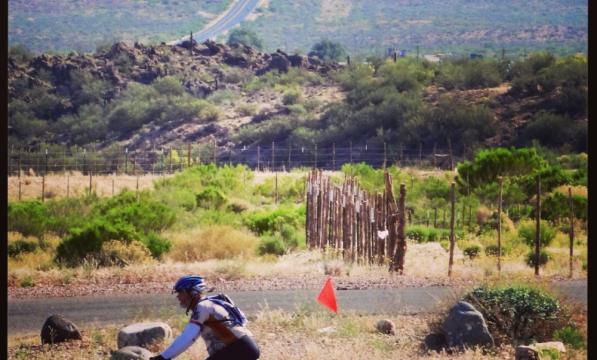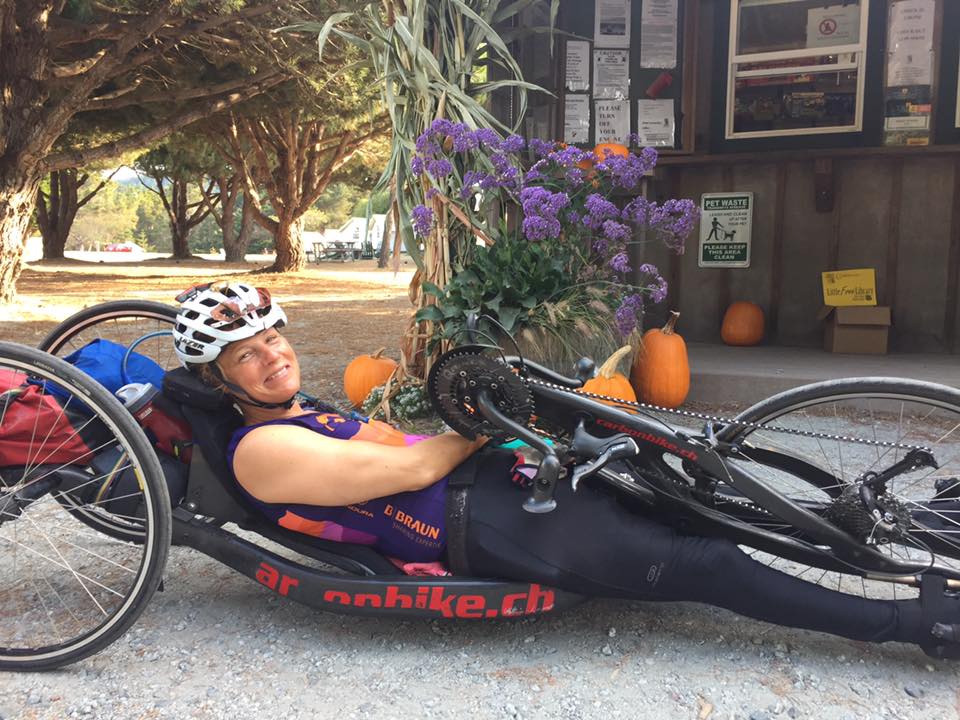Endurance cycling TransAmerica with a bike called Pseudomonas

Cycling 80 to 100+ miles a day every day for seven weeks is simply mind-numbing.
Chronic fatigue, aching legs, arms and backs are coupled with addled brains turned into mush by too many towns and too many miles in too short a time.
The focus is on getting to Boston. Yesterday is ancient history. Moving at an average of 15 mph through the countryside and urban sprawl leaves you after a few weeks not exactly knowing where you have come from or going to. States and hotels merge into one. Photos provide the best fixed memories. The journey however is fantastic. Every day you meet a “trail angel" leaving you with unforgettable memories. The diversity of physical geography and disparity of wealth across USA is stunning. It's all about the people and the journey; the bike is secondary and subservient.
Riding Los Angeles to Boston, 3,415 miles, was a massive cycle ride and an affirming experience, but for me not totally life-changing. In 2006, I could only ride a bike 200 yards. I then lost 170 pounds after an adjustable gastric band was fitted; I had battled with obesity for many years, and the ride was payback time. Two weeks before the cycle I had the band relaxed so I could eat normally. An emotionally difficult procedure, I had grown to dislike food and was fearful of it. How was I going to cope with eating 6,000 calories a day, cycling on an average of 85 miles a day? Would I be fit enough? How would I cope with cycling the equivalent of a running marathon almost every day? Could I ride six century rides?
My daughter, Catherine, a graduate environmental geography student and keen cyclist, joined me for the entire ride. A privilege to spend seven weeks together. Being thirty years younger than me meant I was always chasing her. It was not a race but she always won.
The heat in the Mojave Desert in the first few days felt like riding in an oven. Fitness alone will not carry you through 85 miles a day for multiple days in 119F (46C) degree heat. I've cycled in Cambodia, but never had heat like it in the desert. I was drinking 4 litres of fluid every 25 miles. I could not have got all the fluids and ice without vehicle support. Controlling core temperature in the desert was very important; wearing white arm coolers and then cooling these with water. I came very close to heat exhaustion on one occasion recovering with a quart of chilled chocolate milk and gallons of Gatorade. They say you are never the same after so much Gatorade! My Camelback was an invaluable tool.
Getting the right type of food even in America was a problem for me. With my recently relaxed adjustable gastric band I still do not like food and do not want to eat. But, from a performance standpoint, the essential metric for caloric intake is that you need to consume enough energy to support your activity level.
I guess I was using 5,000 to 6,000 calories a day but the effects of altitude and heat may have made this much greater. I tried not to go anaerobic at any point, a bad thing for an endurance cyclist. When you fail to eat enough, you’re compromising your ability to recover from the cycling, you’re increasing your risk for getting sick, increasing your vulnerability to injury, and hindering your ability to adapt to cycling long distances every day and continue to get stronger.
What I also learnt is that you really have to eat today for what you’re planning on cycling tomorrow. That means pre-loading your energy stores with hearty breakfasts before big rides, so you stand a better chance of mitigating the energy depletion from each day. I seemed to run better on good steak, rather than chicken or fish. On the ride, you have to stay on top of energy, fluid and electrolyte intake, so you minimise the stress you put on your body during the day and the extent of the recovery you’ll need for you to be able to perform again tomorrow.
Gels are a medicine and not a food. Chocolate milk gave me often a remarkable burst of instant energy. Potassium tablets helped prevent muscle cramps. Good quality sleep is vital. As I did so many days riding over seven weeks, I always had less than 24 hours to recover before another big ride. I had a rest day once a week, but mainly slept. I would proactively eat five to ten miles before finishing a day’s riding, to replace the energy stores before the ride ended. If I dug too deep a hole, I may not have been able to refill it in time and bonk.
Being still heavy at 15 stone, climbing was really tough, but I was once 27.5 stone. The road gradients were never much more than 6%, but the climbs can be 15 miles across the Rockies. In Missouri I did 148 roller coaster hills in one day over 82 miles with 5600 feet of climbing. The worst was over once over the Rockies, and the rides were easier but none less long. Some final minor hills over the Green Mountains in New Hampshire and Vermont. Total climbing was just over 91,000 feet.
Physically: I got mild altitude sickness coming over the Rockies, although not that high at 7,500 feet, I was fatigued, fluid depleted and had mild heatstroke. As I climbed I got a rotten headache, mild leg oedema and some leg cellulitis, which quickly resolved with antibiotics and diuretics. I should have taken Diamox. Early on I got nasty blisters on my hands from constantly holding the bars and later mild carpal tunnel from constant vibration with profound numbness and loss of thumb opposition with resultant difficulty changing gears. Early on I dumped my racing saddle and got a lovely Brooks green leather saddle in Flagstaff so never really got saddle sore. With my new saddle I renamed my bike 'pseudomonas', after foul green pus associated with this organism.
My Scott CR1 team road bike began to wear out after 2,500 miles, needing new tyres, new rear wheel, (32 spoke instead of 16), major gear overhaul, loose headset tightening and new shifter. The carbon frame was undamaged. It was a supported trip with Crossroads, so there was a great mechanic with us. We did not have to carry any panniers; accommodation and routes were preplanned; and logistics provided SAG stops every 30 miles or so with snacks, gels, water and even more Gatorade.
Sometimes we weren't exactly certain where they were going to take us to spend the next night or what route we were taking. We had been told but had just forgotten. We rode on paper cue sheets and odometers and invariably did not get lost. No real need for GPS. Cycling should be about the riding and not the technology.
Really memorable parts were the Mojave Desert, the ugly feed lots of Dalhart, Texas, the historical long distance cycling society museum and townspeople whom turned out in Maysville, Missouri with cinnamon rolls and lemonade and the fireman in Boston who showed us his fire-engine and how to slide down his pole.
One of the best parts was climbing Mount Mingus, the 15-mile crawl to the top that took some people three hours. But where was Mount Mingus? Arizona? California? How many state lines exactly had I crossed (14 I think). The map of the United States placed on an easel each afternoon when we checked into a hotel was as much for advertising who we were as it was for us to mark our progress. At first it was disappointing when the black line on the map only inched forward for our day's work. It finally revealed a trail of pride.
The USA was full of surprises. Rude drivers in Missouri and Massachusetts who would prefer to push cyclists off the road versus friendly truck drivers in Arizona who pass giving a thumbs-up signs. The mega-long trains in New Mexico would toot their horns at us.
You just ride; it's a bit like a job! It was an emotional time. I was tearful going over my first big mountain pass, crossing the Continental Divide and finally riding into Boston. The Pacific rear wheel dip and Atlantic dip were duly done. For me, I plan to do the ride again in ten years, while Catherine may do the ride in perhaps fifty years - targets to keep both of us fit and hopefully our weight down. Significantly, I hope my next bike will not be called pseudomonas.
Chris Oliver is a Consultant Orthopaedic Trauma Surgeon in Edinburgh. He is Chairman of the Cyclists' Touring Club for Scotland. Follow on Twitter @cyclingsurgeon





